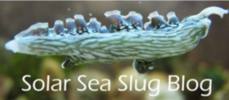Monthly Archives: December 2014
Fade Away
From time to time, one of the slugs starts to shrink and become pale, despite appearing to have normal appetite and behavior. Ultimately, the slug disappears without a trace. My assumption is that this signals senescence, and the greatly reduced slug becomes food for the boisterous collection of detritivores that dwells in the Box of Slugs.
Over the past few weeks, the remaining slugs have all apparently succumbed. Although it’s a bit sad, one does not expect the little guys to live forever, especially since their ages on arrival were completely unknown. Living 5.5 months seems a bit short, but not ridiculously so. The production of a couple of clutches of eggs per slug per week for a few months may also have contributed to their demise. They appeared to have happy little slug lives, and taught us much.
There are new adults on the way from Carolina Biological, plans on the horizon for Box of Slugs II in a new location, and an upgraded culture facility (Box of Slugs 1.1) here at USG. Stay tuned for all that.


Seahorse Sculpture
Although there is activity behind the scenes, it continues to be quiet on the front page here. For the moment, enjoy a photo of a seahorse sculpture on Bainbridge Island, courtesy of Ann and Hans.
Baby Slug Bottleneck
The slug colony, a.k.a. Box of Slugs, has been doing pretty well overall. The slugs have been eating, growing, mating, and laying eggs. The eggs have been hatching, and the veligers have settled as baby slugs. Of the many broods that have been deposited over the past few months, I have collected and hatched about a dozen, so producing juvenile slugs has become routine.
What has been puzzling and frustrating is that the baby slugs are not maturing beyond the first few days. They crawl happily among the macroalgae in the little dishes, but never seem to take in chloroplasts or develop parapodia or rhinophores. I have offered them both Bryopsis and Derbesia, two algal species that are supposedly their favorite first foods, and they appear to be attempting to eat, but the little guys never turn green.
A few observations may or may not be relevant. First, dumping too much Bryopsis into one of their dishes appears to cause immediate and permanent cessation of activity. The simplest interpretation is that, even though Elysia species have been reported to take advantage of the defensive compounds produced by their food plants, too much is simply too much. Also, even though I dip the algae in distilled water for 30-60 seconds before adding it to the cultures, the occasional amphipod, copepod or nasty looking worm sneaks in and may cause a ruckus.
In the end, there are hypotheses to be tested. In order of decreasing likelihood:
1. I am using the wrong food plants. Even though I am feeding species of Bryopsis and Derbesia, the algae were collected from aquaria, so their origin is unknown. I know that the parents love the species of Bryopsis that I am providing, but it may be more difficult for the juveniles to feed on.
2. Temperature. I am currently not controlling their temperature. They hatch on a bookshelf at about 23 degrees C, and then their dishes are moved to the top of the Box of Slugs to provide light when the algae are added. The temperature is probably a bit higher under the LEDs, but I have not measured it.
3. Light. They go from low to relatively high illumination when food plants are added. Maybe they don’t like the light. The little slugs move around happily enough, but who knows.
4. Chemistry. Aside from keeping salinity at 1.025, I do not test or change the water in the crystallization dishes. Given the tiny biomass and the presence of healthy algae, the possibility of waste nitrogen or phosphorous becoming a problem seems slim. Maybe they need to have their water changed to get rid of chemical secreted by the algae?
With finals almost over, I can give some thought to how to separate the variables and get past the roadblock.


Quiet days
Apologies for the radio silence, but little has been happening this past week. The most promising batch of baby slugs has largely disappeared while I was away for the holiday, although the next batch looks excellent. The November 12 clutch, which I have been documenting since it was deposited, has hatched. Unfortunately, I have not found an easy way to video veligers that refuse to stay in one field of view for any length of time. They will probably settle tomorrow, and will be photographed then.
Baby ponies have been hard to find. I rarely see them, but this little one appeared briefly before I left last week. A little more color perhaps, but quite the skinny little fish.
Tomorrow will be a good day for a little maintenance.




Recent Comments